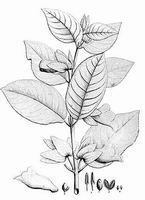
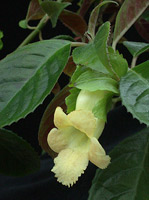
Left: Drymonia serrulata
(Jacq.) Mart., Nov. gen. sp. pl. 3, t. 224 (1829), orig. illustration
Right: Plant of the week,
Smithsonian Institution,
phot. L. Brothers, http://persoon.si.edu/plofweek.index.cfm
Full name and orig. publication: Drymonia Mart., Nov. gen. spec. pl. 3: 57, t. 224 (Jan.-June 1829).
Etymology: From δρυμος, drymos = [oak] wood; in allusion to the plant growing on trees in woods.
Synonyms: Macrochlamys Decne. (1849), Calanthus Oerst. ex Hanst. (1854), Erythranthus Oerst. ex Hanst. (1854), Polythysania Hanst. (1854), Anisoplectus Oerst. (1858), Caloplectus Oerst. (1858), Saccoplectus Oerst. (1858), Alloplectus Mart. subg. Erythranthus (Oerst. ex Hanst.) Hanst. (1865), Alloplectus Mart. subg. Calanthus (Oerst. ex Hanst.) Hanst. (1865), Crantzia Scop. sect. Calanthus (Oerst. ex Hanst.) Fritsch (1894), Crantzia Scop. sect. Macrochalmys (Decne.) Fritsch (1894), Alloplectus Mart. sect. Macrochlamys (Decne.) Dalla Torre & Harms (1904).
Infrafamilial position: Gesnerioid Gesneriaceae (Gesnerioideae) - Episcieae.
Description: Terrestrial or epiphytic (sub)shrubs or lianas. Stems quadrangular or terete, in climbers up to 5 m long, branched or not, often with spreading adventitious roots along the internodes. Leaves opposite, petiolate, ñ isophyllous, membranous or rarely coriaceous. Axillary cymes 1- to several-flowered, flowers clustered; bracteoles often large and leaflike, or small and inconspicuous, often caducous. Flowers often showy and brightly coloured. Sepals often large and coloured or leaflike, free or shortly connate at base, unequal with the uppermost shortest. Corolla oblique in the calyx, usually funnelform and broader toward the mouth, spurred or saccate at the base, throat broad; limb with usually spreading, rounded, often fimbriate lobes, the basal lobes usually larger. Stamens 4, included, filaments adnate to base of corolla tube, didynamous, occasionally contorted; anthers sagittate, broadest at the tip, narrowed toward the base to 2 separate spurs, before anthesis coherent by the sides and faces, with the spurred bases up, dehiscing by 2 to 4 pores, after anthesis the filaments coiling and the anthers separating. Nectary a single dorsal gland. Ovary superior, stigma stomatomorphic or 2-lobed. Fruit a fleshy capsule with brightly orange- or purple-coloured reflexed valves, displaying a cone-shape mass of seeds and pulpy funicles.
Chromosome number: 2n = 18.
Species number: Over 140.
Species names (incl. publication and synonyms): See Skog, L.E. & J.K. Boggan. 2005: World checklist of Gesneriaceae: http://persoon.si.edu/Gesneriaceae/Checklist.
Type species: Drymonia calcarata Mart. = D. serrulata (Jacq.) Mart.
Distribution: Throughout the neotropics, with centre of distribution in Colombia and Ecuador.
Ecology: Terrestrial or epiphytic shrubs and subshrubs, growing in lowland and montane forests.
Notes: The flowers of most species are remarkable for the poricidally dehiscent anthers and "salt-shaker"-like structure of the androecium. The inflorescences are sometimes provided with large, coloured bracteoles being displaced to the subsequent node (recaulescence; reminiscent of Solaneae; Weber 1982). Secretion of oil in the flowers of Drymonia serrulata and their pollination by Epicharis bees was described by Steiner (1985). The genus has been emended by Wiehler (1973) and recently considerably enlarged by the transfer of species formerly attributed to Alloplectus, Paradrymonia and Nautilocalyx. In these species the "salt-shaker-mechanism" seems to have been lost. So it is not surprising to find closely related species with and without poricidal anther dehiscence side by side in the genus (e.g. Drymonia turrialvae / D. ambonensis, formerly Alloplectus ambonensis). Drymonia thus becomes one of the morphologically most diverse genera of neotropical Gesneriaceae (Clark 2005, 2006, Clark et al. 2006).
Selected references: Skog, Ann. Missouri Bot. Gard. 65: 896-918 (1979), reg. rev. (Panama); Weber, Austral. Syst. Bot. Soc. Newsl. 30: 23-41 (1982), infl. morph.; Wiehler, Phytologia 27: 324 (1973), emend.; Wiehler, Selbyana 6: 187 (1983); Steiner, Biotropica 17: 217-229 (1985), pollination ecol.; Chautems in Ribeiro & al., Fl. Res. Ducke (1999) reg. rev.; Feuillet & Steyermark, Fl. Venezuel. Guayana 5 (1999), reg. rev.; Skog, Monogr. Syst. Bot. Missouri Bot. Gard. 85: 1114-1128 (2001), reg. rev. (Nicaragua); Chautems, in Calvacanti & Ramos, Fl. Distrito Federal, Brazil, vol. 3, Brasilia (2003), reg. rev.; Clark, Selbyana 25: 182-209 (2005), rev. of Alloplectus; Clark, Gesneriads 56(3): 20-25 (2006); Clark, Herendeen, Skog & Zimmer Taxon 55: 313-336 (2006), molec. syst.
Bibliography: See Skog, L.E. & J.K. Boggan. 2005. Bibliography of the Gesneriaceae. 2nd edition: http://persoon.si.edu/Gesneriaceae/Bibliography.
Illustrations:

|

|
Drymonia serrulata
(Jacq.) Mart.
[= Drymonia
calcarata Mart., type]
Left: Drymonia serrulata
(Jacq.) Mart., Nov. gen. sp. pl. 3, t. 224 (1829), orig. illustration |
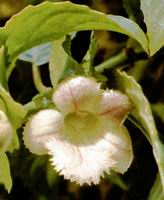
|
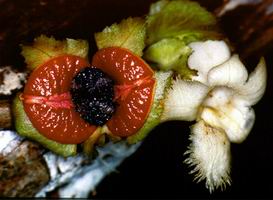
|
Drymonia serrulata (Jacq.) Mart.
Flower and open fruit, phot. A. Chautems |
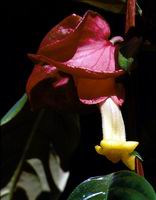
|
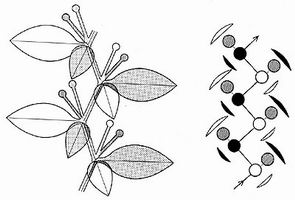
|
Drymonia coccinea
(Aubl.) Wiehler
Left: cult.
BG Vienna, phot. A.
Weber (1978)
|
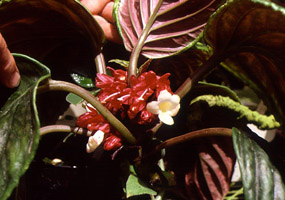 |
Drymonia
turrialvae Hanst.
Cult. Marie Selby BG, phot. A. Weber (1982) |
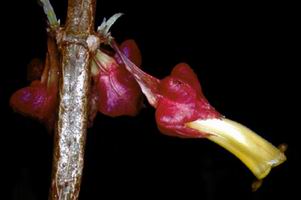 |
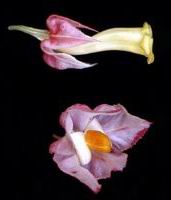 |
Drymonia strigosa (Oerst.) Wiehler
Left: cult. RBG Edinburgh, phot. A. Weber (1998) |
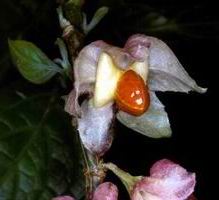 |
Drymonia
strigosa (Oerst.) Wiehler
Display fruit, cult. RBG Edinburgh, phot. A. Weber (1998) |
last modified: 2007-07-05